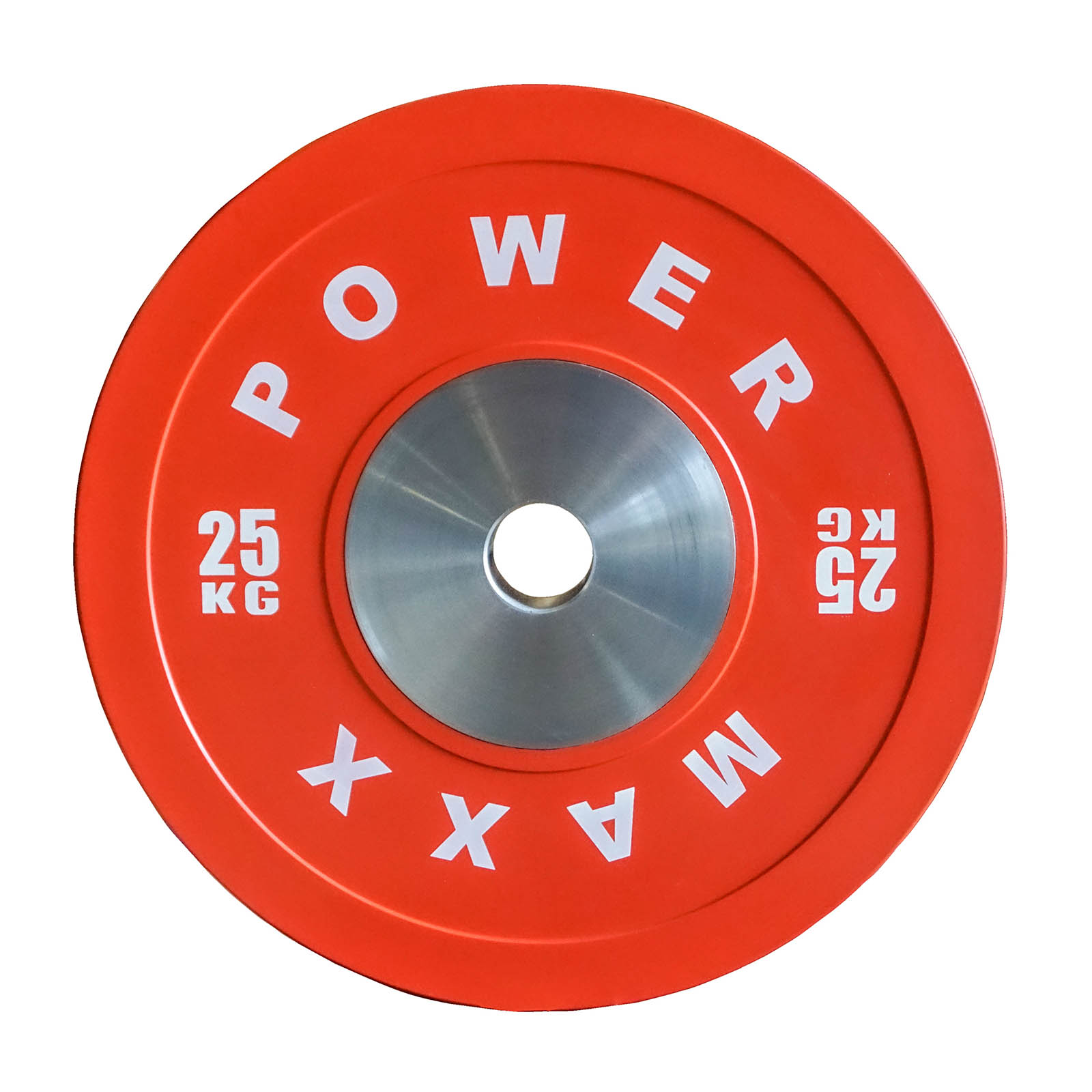
Bumper Weight Plates
Perform your weight lifts without the ear-splitting noise and cracked floors with the help of our bumper weight plates made of tough, durable rubber.
These affordable and shock-absorbing plates come with steel inserts to reduce the plate thickness. Available in black or Olympic colour coding.
Individual Plates Bumper Sets Solid Rubber Bumpers Competition Bumpers Technique Bumpers
- Made of durable solid rubber
- IWF specification
- Minimal weight variation
- Shock absorbing
- Prevent gym floor damage
-
This item is in stock!
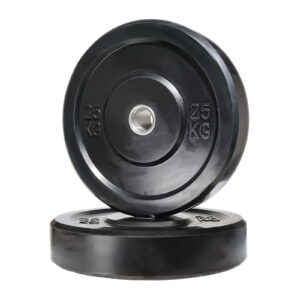
Black Olympic Bumper Weight Plates 5kg-25kg
SKU: FPBLKBP$30.00 – $85.00 View products -
This item is in stock!
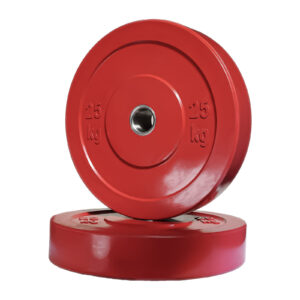
Coloured Olympic Bumper Weight Plates 5kg-25kg
SKU: FPBP$30.00 – $97.00 View products -
This item is in stock!
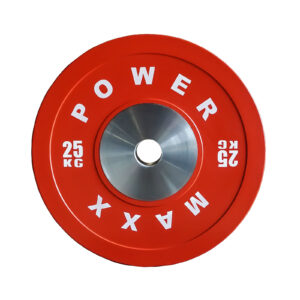
Premium Olympic Bumper Weight Plates 5kg-25kg
SKU: CGPBP$39.00 – $185.00 View products -
This item is in stock!
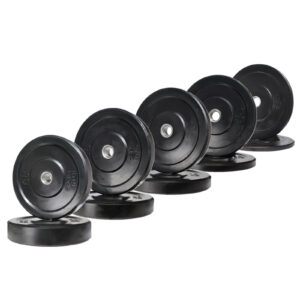
150kg Black Olympic Bumper Weight Plate Set
SKU: FPBPPACKBLK$574.00 Add to cart -
This item is in stock!
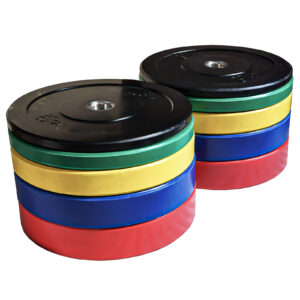
150kg Olympic Bumper Weight Plate Set
SKU: FPBPPACK$682.00 Add to cart -
This item is in stock!
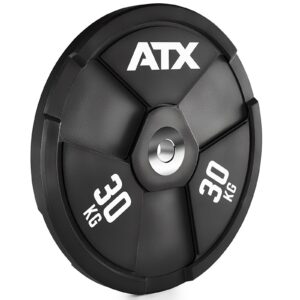
ATX® 30kg Wagon Wheel
SKU: ATX-WW-3000$289.00 Add to cart -
This item is in stock!
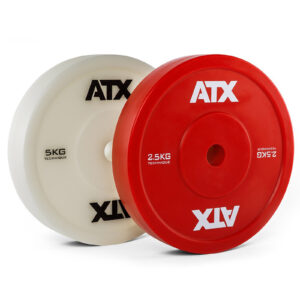
ATX® Olympic Weightlifting Technique Plate
SKU: ATX-WLTP$139.00 – $190.00 View products -
This item is in stock!
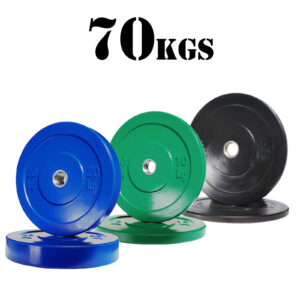
70kg Olympic Bumper Plate Package
SKU: FPBPPACK70$344.00 Add to cart -
This item is in stock!
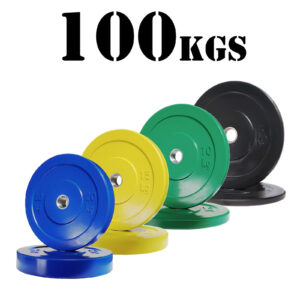
100kg Olympic Bumper Plate Package
SKU: FPBPPACK100$488.00 Add to cart -
This item is in stock!
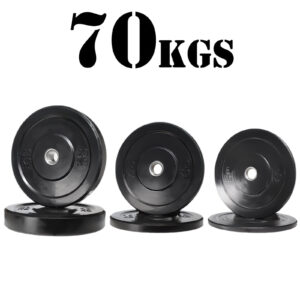
70kg Black Bumper Package
SKU: FPBPPACKBLK70$286.00 Add to cart -
This item is in stock!
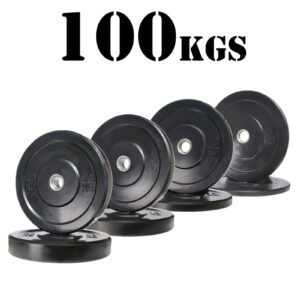
100kg Black Bumper Package
SKU: FPBPPACKBLK100$404.00 Add to cart -
This item is in stock!
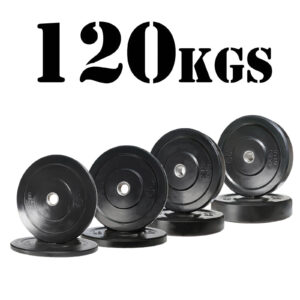
120kg Black Olympic Bumper Plate Package
SKU: FPBPPACKBLK120$456.00 Add to cart
Showing 1–12 of 14 results
Performing the Olympic lifts – snatches and clean and jerks will invariably involve dropping the barbell from height. You will also be doing controlled drops when attempting a heavy deadlift. This is speciality lifting and will require speciality gym equipment.
Bumper plates are designed to be dropped. Traditional weight plates that are made from cast iron are not designed for this type of lifting. These cast iron plates will wreak havoc on your barbell and flooring.
Bumper plates are made from solid rubber which provides shock absorption.
Break Records Not Your Gym Equipment
If you have been following a basic weight training program for a while and have built up a solid base line of strength it might be time to add some variety to your training. The Olympic lifts are very advanced, so I don’t recommend these unless you get shown how to do them properly.
Deadlifts on the other hand are a lot easier to pick up and are recognised as one of the best exercises for building brute strength. This is when it is time to invest in some rubber plates.
Unlike cast iron plates, bumper plates are all the same diameter (IWF standard of 450 mm). A 5kg bumper plate has the same diameter as a 25kg bumper plate. Why is this important?
Firstly, it will get the barbell at the right starting height no matter what weight you start with. The diameter of the weight plate determines how far from the floor the barbell sits. If you used normal 10kg plates you would have to bend over further than with using bumper plates.
By starting at the right height regardless of the weight on the barbell, you can really focus on the form of the various lifts.
The other reason why the standard diameter is important is that it expands the load bearing area. As the bumper weights are the same diameter, each plate contacts the floor. This disperses the impact from dropping the barbell for your floor, barbell and plates.
Bumper Plates on a Budget
The surge in demand for Olympic bumper plates has dramatically reduced their cost. They are cheaper now than 15 years ago. Even though these are cheap bumper plates, they are very good quality especially for the price.
Our Eco Bumpers come with following features:
- IWF Standard sizing of 450 mm.
- Durable rubber absorbs shock, reduces noise and protects your floor (up to some extent).
- Successfully passed 10,000 drop test.
- 88 Shore A Durometer Scale.
- 51mm inner steel ring.
- Available in All black or Olympic Colour Coding.
Previously bumper plates were a luxury that few could afford. Now at these prices, even a relatively inexperienced lifter can justify this investment. For deadlifts alone, a bumper set will yield a fantastic return.
As you gain experience you may want to start trying some Olympic lifts. Having a pair of 5kg bumpers will allow you to work your technique – this is a must for such complicated, dynamic movements.
The downside to this style of plate is that it is made from solid rubber. The plate has a much larger width than a normal Olympic weight plate. This becomes an issue as you get stronger. You won’t be able to fit the required weight onto your barbell sleeves. A good problem to have!
Lift Hard and Heavy
If you need bumper plates for a gym, or you are a serious home lifter, then investing in premium bumpers is a wise choice.
They come with steel inserts which greatly reduces the thickness of the plate. For example, 25 kg plate is only 51mm thick! This avoids the issue experienced with the solid rubber bumpers above of being able to fit enough weight onto the barbell.
The Power Maxx Premium Bumpers feature the following:
- Solid steel inserts.
- Olympic colour coding
- IWF Specification diameter of 450 mm.
- Made out of high-quality virgin rubber which will not distort or crack from use.
- Minimal weight variance
These are premium plates at premium price. They have been made from the highest quality materials and have been tested in high performance gyms throughout Australia.
Choosing the Right Plate
Unless you are doing Olympic lifts or deadlifts, you don’t really need bumper plates. With the fancy colours and beefy look, they look better than your plain vanilla Olympic plate. But there are more important things to consider than looking cool.
Bumper plates don’t have handles like our rubber coated cast iron plates. This makes them harder to manoeuvre around the gym. You can’t carry around the 20’s and 25’s one in each hand. If you have plate loaded machines, then this will take you longer to change weights between sets.
You really notice this when loading the barbell for squats or similar plate loaded machine where the horns are up high. If you have inexperienced lifters training in your gym then I strongly advise using bumper plates for this purpose.
But if you are doing the lifts (deadlifts, snatch, clean and jerk) mentioned above with decent weight then you should invest in bumper plates.
If you are not planning on breaking Australian or world records, I would recommend our eco bumper plates. You simply can’t beat them for quality and performance at this price.
A 200kg deadlift is nothing these days. If you own a gym or are one of these beasts that can move mountains of weight, then you need to get premium bumper plates.
Bumper Weight PlatesFrequently Asked Questions
Are Bumper Plates easier to Deadlift?
A 20kg bumper plate will be easier to deadlift than a normal 20kg Olympic plate if the Olympic plate is less than 450mm in diameter. Bumper plates are 450mm in diameter. Starting the lift from a higher position will always be easier.
Are Bumper Plates lighter?
A 20kg bumper plate is the same weight as a 20kg weight plate. They are designed to be dropped. They are made from solid rubber, so they are often thicker than the equivalent plate in a traditional design.
Technique plates look like bumper plates. They are very light – under 5kgs. Some people may confuse someone effortlessly working on their form with technique plates with someone struggling under the load of normal plates.
How many Bumper Plates fit on a Bar?
This will all depend on what type of bumper plates you have. The more affordable bumper plates tend to be thicker than the premium bumper plates. For example, our affordable 25kg bumper plates are 90mm in width.
The maximum loadable space on one of our barbells is around 400mm. You can place 4 of these bumpers on here without collars. Or you could fit on 7 of the Premium bumpers on which are only 51mm wide.
However Olympic barbells come in varying sizes too. The sleeves can vary in length. To correctly work out how many bumpers will fit you will need both the sleeve length and bumper width. Plus, you will also need to take into account the width of your collars.
What are Bumper Plates made of?
Bumper plates are made from solid rubber. Entry level bumpers are made wholly from solid rubber. The drawback of this design is that the plate is thick. 25kg bumper plates can be around 90mm with this construction.
For the average lifter this is not a drama. You won’t lift enough weight to run out of space on your barbell. Advance trainers will eventually run out of space.
Competition style bumpers were designed for Olympic weightlifting where massive weight is lifted. These bumpers are much thinner so more can be loaded on to the bar. To reduce the thickness these bumpers, have steel plates inserted into the rubber.
Why are Bumper Plates so Expensive?
Bumper plates are not expensive these days. The basic solid black bumper plates are cheaper now, compared to the rubber coated cast iron plates.
The competition style bumper plates are expensive though. These plates have a steel insert which makes the plate thinner than the cheaper solid bumper plates. Often these plates have much more exacting calibration in terms of weight. This further complicates production and adds expense.
Can you Bench Press with Bumper Plates?
You certainly can bench press with bumper plates. The only downside would be if you start lifting heavier weight. Bumper plates are usually wider/thicker than your usual weight plate. Depending on the width of your bumper plates, you may not be able to fit all the weight that you need.
Can you Mix Bumper Plates with Regular Plates?
Yes, you can mix bumper and regular plates. As a matter of fact, that is one of my hacks when deadlifting. I just load up a pair of solid 25kg rubber bumper plates. That gives you 70kg on the bar for a nice warm up. From then I just load up my normal Olympic weight plates.
Using this method, you do not need a deadlift jack, or similar implement to lift the bar, like you would have to do when using bumper plates exclusively. That is provided the normal Olympic plates are below the 450mm diameter of the bumper plates. I can’t tell you how simple and easy this makes a deadlift session.
The only time I wouldn’t recommend using a mix of Olympic and Bumper plates is when your regular plates are 450mm. You wouldn’t want to perform an exercise where dropping is involved, like the Olympic lifts or a deadlift.
This has the potential to damage your barbell, plates, or floor.
How long do Bumper Plates last?
This will depend on the quality, type and what you do with your bumper plates. If you are doing Olympic Weightlifting, your bumper plates will wear quicker than if you are just doing some deadlifts each week. Especially if you are using lighter bumper plates. We do not advise using solid rubber 5kg or 10kg Bumper plates for Olympic lifts where you are dropping them from overhead.
Competition bumper plates are designed for this style of work, so if you are planning on getting serious about Olympic lifting then invest in quality. Or if you need bumper plates for a gym then it is probably worth spending the extra too.
What do the Bumper Plate colours mean?
The bumper plates are coloured to let you know the weight of each plate:
25kg-Red,
20kg-Blue,
15kg-Yellow,
10kg-Green,
5kg can be either Black or White.
This makes each plate easily recognisable when changing plates in the gym or in competition. When the plates are just plain black, it can sometimes be hard to see what weight each plate is.
Watch an Olympic Weightlifting or Powerlifting competition and you will see the importance. Lifters perform their lifts in groups, one after the other. They nominate the weight they lift, and it varies between lifters. Between each lift the weight is changed quickly. Quick identification is crucial. Plus the colours make it easy for all the officials and spectators to confirm the correct weight is on the barbell.
